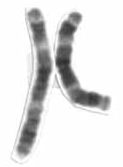
Photo from wikipedia
Purpose To understand the consequences of the 3q29 deletion on medical, neurodevelopmental, psychiatric, brain structural, and neurological sequalae by systematic evaluation of affected individuals. To develop evidence-based recommendations using these… Click to show full abstract
Purpose To understand the consequences of the 3q29 deletion on medical, neurodevelopmental, psychiatric, brain structural, and neurological sequalae by systematic evaluation of affected individuals. To develop evidence-based recommendations using these data for effective clinical care. Methods Thirty-two individuals with the 3q29 deletion were evaluated using a defined phenotyping protocol and standardized data collection instruments. Results Medical manifestations were varied and reported across nearly every organ system. The most severe manifestations were congenital heart defects (25%) and the most common were gastrointestinal symptoms (81%). Physical examination revealed a high proportion of musculoskeletal findings (81%). Neurodevelopmental phenotypes represent a significant burden and include intellectual disability (34%), autism spectrum disorder (38%), executive function deficits (46%), and graphomotor weakness (78%). Psychiatric illness manifests across the lifespan with psychosis prodrome (15%), psychosis (20%), anxiety disorders (40%), and attention deficit–hyperactivity disorder (ADHD) (63%). Neuroimaging revealed structural anomalies of the posterior fossa, but on neurological exam study subjects displayed only mild or moderate motor vulnerabilities. Conclusion By direct evaluation of 3q29 deletion study subjects, we document common features of the syndrome, including a high burden of neurodevelopmental and neuropsychiatric phenotypes. Evidence-based recommendations for evaluation, referral, and management are provided to help guide clinicians in the care of 3q29 deletion patients.
Journal Title: Genetics in Medicine
Year Published: 2021
Link to full text (if available)
Share on Social Media: Sign Up to like & get
recommendations!